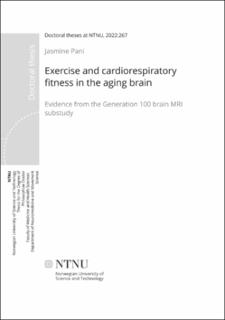| dc.contributor.advisor | Håberg, Asta Kristine | |
| dc.contributor.advisor | Hansen, Tor Ivar | |
| dc.contributor.advisor | Pintzka, Carl Wolfgang Schøyen | |
| dc.contributor.author | Pani, Jasmine | |
| dc.date.accessioned | 2022-09-28T13:19:16Z | |
| dc.date.available | 2022-09-28T13:19:16Z | |
| dc.date.issued | 2022 | |
| dc.identifier.isbn | 978-82-326-5337-9 | |
| dc.identifier.issn | 2703-8084 | |
| dc.identifier.uri | https://hdl.handle.net/11250/3022323 | |
| dc.description.abstract | As we age, the body as well as the brain changes in shape and function. Some of these changes are common and defined as “typical aging”, others are pathological. The world’s population is growing older, and it is estimated that in 2050 16% will be 65 and older compared to 9% in 2019. Since the largest risk of developing dementia is age, this means that the prevalence of dementia will rise, and it is estimated to triple by 2050. Physical activity has been shown to reduce the prevalence of Alzheimer’s disease, which is the most common type of dementia worldwide. Moreover, exercise has the potential to limit the degree of atrophy associated with typical aging and possibly increase brain volumes in both typical agers and dementia patients.
In all the three studies in this thesis, I investigated the effects of exercise training on brain health in a subsample of older adults from the general population included in the Generation 100 RCT Study. At baseline the sample consisted of 105 cognitively intact participants aged between 70 to 77, without neurological illnesses such as dementia. The participants were randomized in three groups in which two were different in terms of exercise intensity (moderate and high) and the other was a control condition based on following the national physical activity guidelines.
In paper 1, I investigated the effects of 5-years of exercise intervention on brain volumes from T1- weighted brain MRI scans obtained at 3 tesla. In paper 2, I used the same data as in Paper 1, but applied a newly devised computational method to investigate if overall structural brain complexity differed between the groups. Paper 3 focused on white matter (WM) microstructural organization assessed with diffusion tensor imaging. In addition to the group effect, I also investigated the effect of CRF on brain volumes, structural complexity and WM microstructural organization.
Overall, the three studies do not support a role of exercise either at high or medium intensity to impede or delay brain atrophy or WM microstructural damage. However, cardiorespiratory fitness (CRF), which is a measure of physical fitness, was positively associated with cortical volume, WM microstructural organization and cortical and temporal lobe structural complexity. Taken together, the results highlight that entering old age with higher CRF, and not exercise intensity, is beneficial to the brain. | |
| dc.language.iso | eng | en_US |
| dc.publisher | NTNU | en_US |
| dc.relation.ispartofseries | Doctoral theses at NTNU;2022:267 | |
| dc.relation.haspart | Paper 1:
Pani, Jasmine; Eikenes, Live; Reitlo, Line Skarsem; Stensvold, Dorthe; Wisløff, Ulrik; Håberg, Asta.
Pani, Jasmine; Reitlo, Line S.; Evensmoen, Hallvard Røe; Lydersen, Stian; Wisløff, Ulrik; Stensvold, Dorthe; Håberg, Asta.
Effect of 5 years of exercise intervention at different intensities on brain structure in older adults from the general population: A generation 100 substudy. Clinical Interventions in Aging 2021 ;Volum 16. s. 1485-1501
https://doi.org/10.2147/CIA.S318679
This work is published and licensed by Dove Medical Press Limited. The full terms of this license are available at https://www.dovepress.com/terms.php and incorporate the Creative Commons Attribution - Non Commercial (unported, v3.0) License. (CC BY-NC 3.0) | |
| dc.relation.haspart | Paper 2:
Pani, Jasmine; Marzi, Chiara; Stensvold, Dorthe; Wisløff, Ulrik; Håberg, Asta; Diciotti, Stefano.
Longitudinal study of the effect of a 5-year exercise intervention on structural brain complexity in older adults. A Generation 100 substudy. NeuroImage 2022 ;Volum 256
https://doi.org/10.1016/j.neuroimage.2022.119226
This is an open access article under the CC BY license | |
| dc.relation.haspart | Paper 3:
Pani, Jasmine; Eikenes, Live; Reitlo, Line Skarsem; Stensvold, Dorthe; Wisløff, Ulrik; Håberg, Asta.
Effects of a 5-Year Exercise Intervention on White Matter Microstructural Organization in Older Adults. A Generation 100 Substudy. Frontiers in Aging Neuroscience 2022 ;Volum 14.
https://doi.org/10.3389/fnagi.2022.859383
This is an open-access article distributed under the terms of the Creative Commons Attribution License (CC BY). | |
| dc.title | Exercise and cardiorespiratory fitness in the aging brain: evidence from the Generation 100 brain MRI substudy | en_US |
| dc.type | Doctoral thesis | en_US |
| dc.subject.nsi | VDP::Medical disciplines: 700::Health sciences: 800 | en_US |
| dc.description.localcode | Digital fulltext is not available | en_US |
